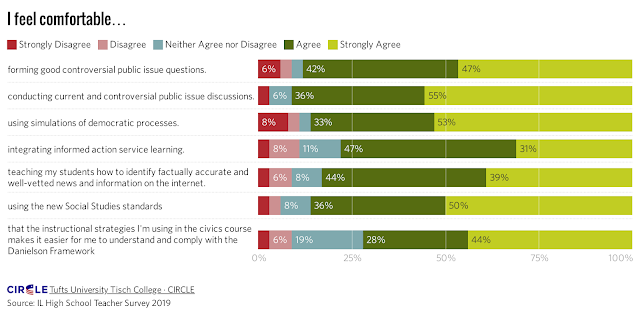The Challenges of Sustaining Civic Learning in Illinois Schools
by Shawn P. Healy, PhD, Democracy Program Director
Two weeks ago we released a summative report on the #CivicsIsBack campaign produced by the Center for Information Research on Civic Learning and Engagement (CIRCLE) at Tufts University titled “Building for Better Democracy Together.” Subsequent posts respectively reviewed the impact of the campaign on teachers, schools, students, and our civic education nonprofit partners, and CIRCLE’s overall assessment of our civics course implementation model. This fourth installment of a five-part series will review CIRCLE’s assessment of the model’s sustainability.Teachers expressed broad comfort in wielding the instructional practices embedded in the new high school civics course (discussion, service learning, and simulations), teaching media literacy, and using the revised K-12 social studies standards. A strong majority of teachers also saw alignment between these instructional approaches and their professional evaluation via the Danielson Framework.
Of the four instructional practices embedded in the civics course requirement, teachers felt most comfortable facilitating public issues discussions and least comfortable structuring informed action and service learning opportunities for students.
In assessing the course and standards implementation challenges of their peers, teachers prioritized time constraints (echoing the finding in our post on implementation impacts), followed by finding the resources to implement the policies, and explaining them to parents, community members, and school leaders.
An encouraging finding from our perspective was the heavy traffic to IllinoisCivics.org, our online hub for civics course and social studies standards implementation. CIRCLE found:
More than three-fourths of teachers (77%) have used the IllinoisCivics.org website. Through the website, teachers have accessed simulations and online games, teacher resources, information on the best practices, and lesson plans.
Looking forward, teachers deem their social studies department chairs and peers most committed to ensuring students receive civic learning opportunities in line with the civics course requirement and social studies standards now and in the future. They sense similar commitment among school principals, but less support from district superintendents. Finally, commitments among parents and community leaders are shakier or unknown.
CIRCLE concluded that “…the peer-to-peer network of existing institutions, nonprofits, funders, and teacher leaders and supportive district leaders is one of the most important infrastructures that the #CivicsIsBack resources and staff helped to build.” CIRCLE cited the “…importance of community coming together, namely, the funding community coming together to provide financial resources, the McCormick Foundation team’s leadership both as a funder and as a strategic leader, embrace of geographical and cultural diversity within the state, and authentic value and respect given to teachers.”








Comments
Post a Comment